- a long time ago, i.e.: shortly after the disappearance of the saurians, there have been dive-"computers" as well ...
- N.B.: i didn't dive with these things and they are as well not in my museum
- but also I wanted to share with the diving community ...
- I recieved this information from my friends Karl E. Huggins, Catalina Hyperbaric Research;
- and from Ron Nishi, then DCIEM and, as well
- directly from the U.S.N. NEDU reports, the reports of United States Navy Experimental Diving Unit
- sources: pls. cf. below

- this animal is the "Decomputer Mark I"
- a pneumatic thing with 2 compartiments (t1/2: 40 and 75 Min.) made by FOXBORO
- the allowed super-saturation ratio for both compartments was 1.75 : 1
- it has been developped in 1955 and then given to the NEDU in order to test
- it didn't became widely used because the stop times diverted by much from the USN table
- this is probably worldwide the first electronic dive computer
- it is from 1963 and has been developped by TRACOR, a subsidiary of the Union Carbide Corp.,
- in conjunction with the NEDU
- the display shows the safe ascend depth in feet
- it utilizes a 10-fold RC mesh for the simulation of a simple diffusion equation
- due to the strong temperature dependancy it never left the test bed at NEDU
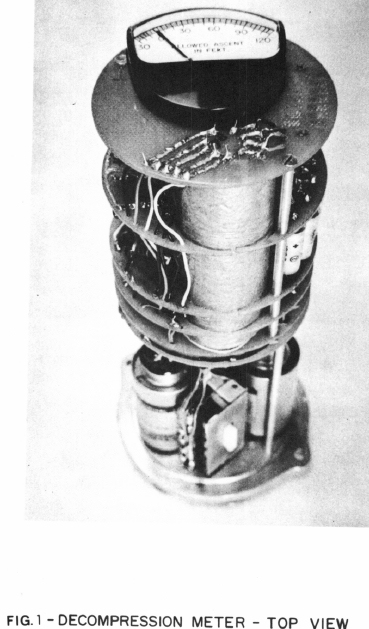
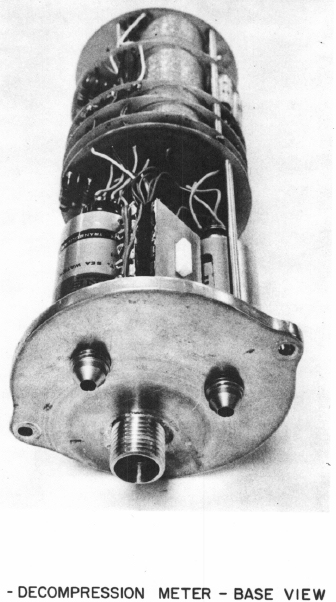
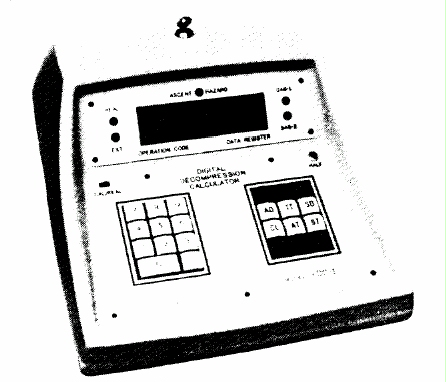
- this thing is a desktop computer, developped by the DCIEM and CTF, Inc.
- it's the: XDC-1 from 1970
- it worked in conjunction with a "pneumo hose" (an air hose open on one end)
- this pneumofathometer was attached to a diver
- so the depths could be monitored on-line
- there was a Kidd-Stubbs Model inside, and with the dive time
- it gave the decompression times for this serial 4 compartment model
- the next one features a follow-up to the XDC-1, it is the:
- XDC-2, this one is still in use (2012) in the Hyperbaric Chamber of the
Sacre Coeur Hospital in Montreal!

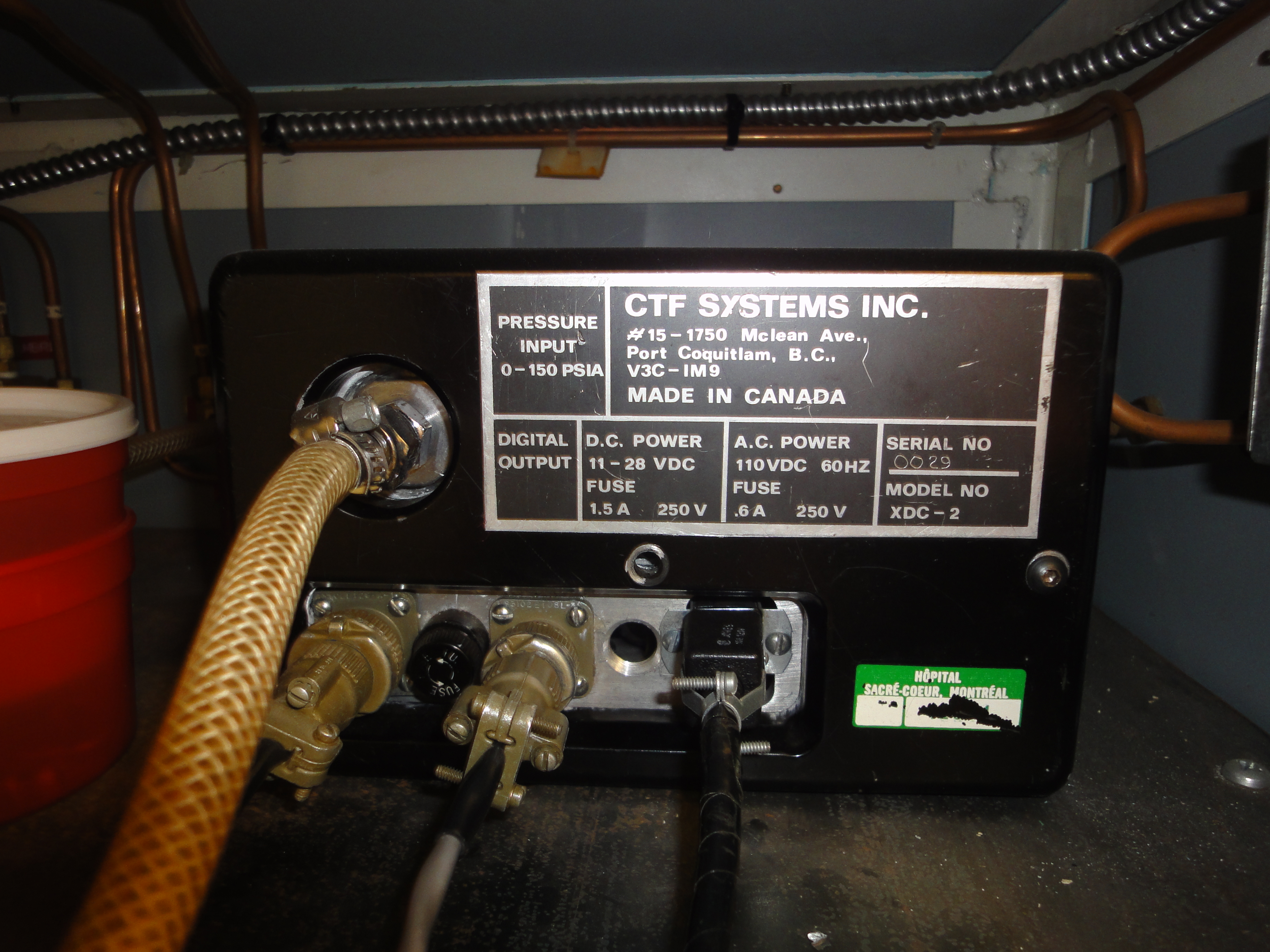
- I recieved these pictures from:
- Marc Essertaize, Chief Operator
- you see the front with the displays
- and the back with the connections to various power sources
- and the pneumo hose (Pressure Input, 0 - 150 PSIA) which is good up to 10.3 Bar
- this thing i found in my favourite deco-book [102] Decompression Sickness from Hills, B.A. on p. 133:
- you could use up to 4 gas mixes per dive profile
- the depths are coded in 10 feet increments, the dive time in 1, 2, 5 or 10 min. increments
- via little pegs in a control board
- it is approx. from the beginning of the 1970's and was able
- to check the deco-obligations and as well it checked the ox-tox dose

- This little drawing is from an US Patent of the year 1975!
- it is from Kirk E. Jennings, Kaneohe, Hawaii, US Patent No. 4005282,
- already that time with a trend-setting design:
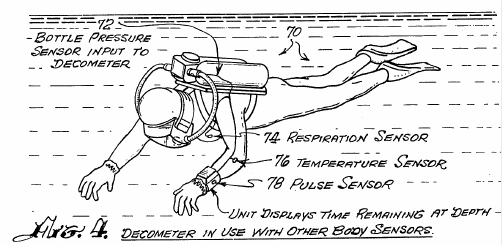
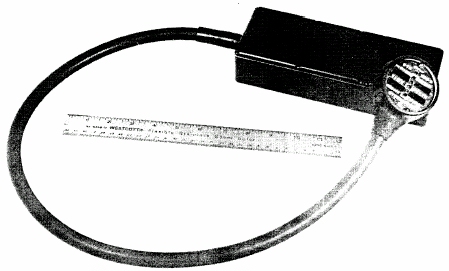
- already around 1979 entered the Cyberdiver Series the american / canadian market
- this one is the Cyberdiver or resp. the XDC-3, the direct predecessor
- this is, worldwide, the first real divecomputer, i.e.:
- this box calculates via a microprocessor a full-blown decompression model in realtime under water!
- up to 4 h operation with a four(!) 9 V blocks, already a hose for a HP connection to the tank
- it displayed the tank pressure and the decompression status according to the canadian models
- more than 700 units were sold until the early 80's
- as well in 1979 there was the XDC-4 for mixgases up to 600 ft!
- It was a sophisticated Multi-CPU system and could handle different deco models: it did not make it to the market
- all these machines have been developped and built by DCIEM and CTF Systems, Inc.
- Already since summer 1977 (according to FACEPLATE) the USN had a little diver portable system
- it was called: Underwater Decompression Computer, UDC:
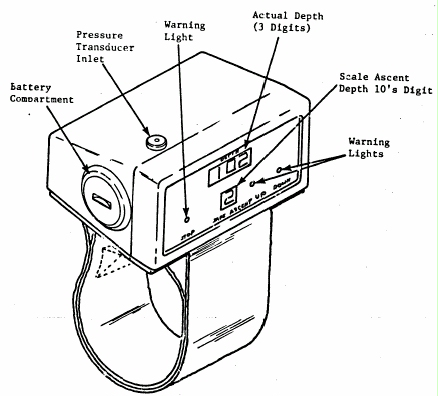
- it was used intensively in 1983 and 1984, especially to validate the new decompression model:
- the VVAL18, which is an E-L model for the UBA MK 15 / 16
- for us regular folks, who have not been diving in the USN:
- UBA = Underwater Breathing Apparatus, E-L = Exponential on-gassing, linear off-gassing,
- Sources for these Informations:
- Green, N. H., Woodward, B. The Evolution of Divers' Decompression Computers (1995), Society of Underwater Technology, Vol. 19, No. 1, p 9 - 23
- NEDU Report 1-63, R.D. Workman: Evaluation of a Decompression Computer developed for Divers
- NEDU Report 11-80, NAVY EXPERIMENTAL DIVING UNIT, REPORT NO. 11-80,
TESTING OF DECOMPRESSION ALGORITHMS FOR USE IN THE U. S. NAVY UNDERWATER DECOMPRESSION COMPUTER, PHASE I
Edward D. Thalmann, CDR, MC, USN
- NAVY EXPERIMENTAL DIVING UNIT, REPORT NO. 1-84,
PHASE I1 TESTING OF DECOMPRESSION ALGORITHMS
FOR USE IN THE U. S. NAVY
UNDERWATER DECOMPRESSION COMPUTER
Edward D. Thalmann, CDR, MC, USN, JANUARY 1984
- NEDU Report 10-86, TEST AND EVALUATION OF 2 PROTOTYPE MODEL UNDERWATER DECOMPRESSION MONITORS
- Microprocessor Applications to Multi-Level Air Decompression Problems, Karl E. Huggins, 1987, Michu-SG-87-201
- Proceedings of the AAUS Dive Computer Workshop, September 1988, USCSG-TR-01-89
- The Dynamcis of Decompression, Workbook, FIRST EDITION, KARL E. HUGGINS, THE UNIVERSITY OF MICHIGAN,
ANN ARBOR, MICHIGAN, 1992
- Developing the NEW US Navy Tables
(a copy from: aquaCorps Journal N8, p. 55 - 60)
back to: Contents
back to: DIVE TABLES homepage


















